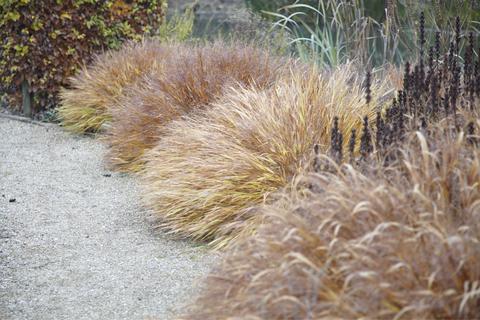Japanese forest grass
Japanese forest grass prefers fresh locations and is ideal as groundcover or for flower bed planting. Here’s the correct way to plant and care for these grass species.
Factsheet
- Growth type
-
- Grass
- Growth height (from)
- from 30 cm to 90 cm
- Growth width (from)
- from 30 cm to 50 cm
- Growth characteristics
-
- sweeping
- overhanging
- horst-forming
- foothills
- Flower color
-
- green
- brown
- Flowering time (month)
-
- July to August
- Flower shape
-
- panicles
- Flower characteristics
-
- unimpressive
- Leaf color
-
- green
- page format
-
- strap-shaped
- narrow lanceolate
- Sheet properties
-
- Autumn coloring
- Light
-
- scattered light to semi-shade
- Soil type
-
- sandy to loamy
- Soil Moisture
-
- fresh to humid
- ph value
-
- neutral to weakly acidic
- Lime compatibility
-
- lime-tolerant to sensitive to lime
- Nutrient requirements
-
- nutrient-rich
- Humus
-
- rich in humus
- Decorative or utility value
-
- Leaf ornaments
- picturesque growth
- Winter Hardness
-
- hardy
- Climate zones according to USDA
-
- 7
- areas of life
-
- G2
- GR2
- FR2
- ST2
- Use
-
- Flowerbeds
- Borders
- Single position
- Group planting
- Pond planting
- Underplanting
- Surface greening
- Rebates
- Garden style
-
- Flower garden
- Formal garden
- Japanese Garden
- natural garden
- Forest Garden
Japanese forest grass (Hakonechloa macra), also referred to as Hakone grass, is a dwarf reed from the genus Hakonechloa within the Poaceae family. As its name suggests, Japanese forest grass is native to the wet precipices in the mountains on Honshu, Japan’s main island. Among other places, the species grows in the region of the Hakone mountain, from which the genus name is derived.
Hakonechloa macra is a herby, long-lasting and relatively slow growing plant, with stems which form loosely overhanging waves 11.81 to 35.43 inches tall. The late shooting grass forms underground offshoots. Japanese forest grass grows slowly but continuously in diameter by spreading side shoots.
The narrow, lanceolate foliage of Japanese forest grass can grow up to 7.87 inches long and 0.39 to 0.79 inches wide and is reminiscent of bamboo with its strong green color. During the fall it takes on a yellow to bronze color.

In the summer, from around July to August, inconspicuous, green-brown panicles appear close to the end of the stalks. The spikelets are up to 0.79 inches long.
Japanese forest grass thrives in an off-sunny to semi-shady location, ideally in a cooler environment, similar to its native location. The grass even grows in full sunlight in more moist and cool areas. The warmer the location, the more shade Japanese forest grass needs.
Japanese forest grass thrives best in fresh to moist, nutrient-rich, humus soils.
Place the decorative grass with its root ball in a sufficiently large planting hole in the spring. It’s best to keep a planting distance of around 19.69 inches from other plants. However, if you want to use Japanese forest grass as groundcover, you should plant the grass tightly together, so the clump only spreads slowly. After planting, the decorative grass should be watered well.
Once it has grown in, Hakonechloa macra doesn’t require any special care. When the late frosts threaten, the grass benefits from a thin layer of spruce brush wood.
You should divide the Japanese forest grass in the spring. Late spring is also the best time for replanting and any necessary pruning, as the grass species grows flat roots and could otherwise threatened by frost damage in the fall.

The relatively slow growing, overhanging decorative grass is perfect as groundcover and to plant around the edges of flower beds. The overhanging grass leaf crown of the also looks highly decorative in containers with a volume capacity of at least 1.32 to 1.64 gallons. Japanese forest grass is also suitable as underplanting and as an eyecatcher in shady areas. It looks particularly good in combination with hostas, ferns, and plants with red foliage.
There are different varieties in addition to the green-foliage species, including the conspicuous, striped variety ‘Aureola’, which is widespread In contrast, the green foliage species tolerates the sun better, is more winter hardy, and grows more quickly. ‘Albovariegata’ is a variety with green foliage and wide, white lengthwise stripes. The variety grows more rapidly and taller than ‘Aureola’. ‘All Gold’ has vibrant, yellow leaves and is suitable for sunny locations.

Hakonechloa macra is a vigorous self-sower, but not in dry soils. You can propagate larger clumps through division in the early spring.
Japanese forest grass is not sensitive to diseases and pests.

